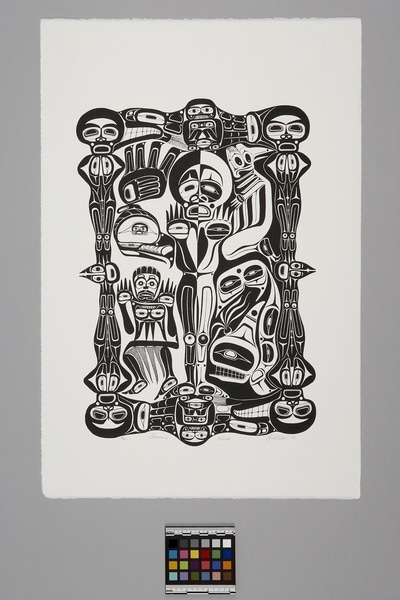Shaman's World Item Number: Nb3.1390 from the MOA: University of British Columbia

Description
Complex stylized black images in a roughly rectangular shape. Central frontal figure is bilaterally symmetrical black on white and white on black opposing on each side. Skull shaped head with tapering oval eyes with split u's above, ovoid nostrils, and ovoids with ovoid mouth. Eye shapes in hands by chin, circular knees, split, elongated u forms on either side, and eye shapes in splayed feet. On the left side at the top of the figure in black on white, there is a hooked beaked, profile bird head with face in ovoid eye and wing/tail shape above. Below, there is frontal figure with a series of split u's across the crown, raised hands, upside down head for torso, and crosshatched skirt-like tassels between legs. On the right of the figure in white on black, there is a bird-human at the top with a fetal-like head and body in crouch. Below, there is a whale with curved bands from the spout, even, closed teeth, and a series of ovoids along the elongated body and the fluked tail at the top. On the outside edges, there are four figures. The bottom two are upside down with feet merging with the two top figures. Each has a skull-like head, bent arms, round knees with elongated u forms for the leg sections, and one foot in profile to the outside. Inside shares ovoid with opposing figure. Across the top and the bottom, there is a serpent-like image and the bottom is upside down. Head on the left at the top and right on the bottom. Central frontal figure with a series of eye shapes. Written pencil inscription across bottom reads '10/50 Shaman's World Lyle Wilson '80.' The print is on a vertically rectangular, white deckle edged paper piece.
History Of Use
Northwest Coast serigraphs are a contemporary art form, deriving from early 20th century drawings of traditional crest and decorative designs, commissioned by anthropologists and undertaken by artists such as Charles Edenshaw. Residential schools reinforced the medium, while discouraging the use of traditional themes. An important series of traditional designs in coloured pencil and watercolour were done by Mungo Martin for UBC in 1949-50. The 1960's saw the rapid growth of prints, first in unlimited poster editions, and later with the establishment of the Gitanmaax School of Northwest Coast Indian Art at 'Ksan (1967), and of the Northwest Coast Indian Artists Guild (1977), limited edition art runs became the standard. Northwest Coast silkscreen prints are part of the mainstream art market, as well as, functioning within the native context as potlatch gifts, and commemorative prints. Although, there are distinctive regional styles, individual artists may work in several styles, or apply unique themes and variations to specific works.
Cultural Context
contemporary art
Item History
- Made by Lyle Wilson (Maker) in Kitamaat, British Columbia, Canada during 1980
- Owned by Lyle Wilson before August 7, 1987
- Received from Museum of Anthropology Shop Volunteers (Funding source) and Lyle Wilson (Seller) on August 7, 1987
What
- Name
- Shaman's World
- Identification Number
- Nb3.1390
- Type of Item
- Manufacturing Technique
- silkscreened
- Overall
- height 57.0 cm, width 38.0 cm, depth 0.1 cm
Who
- Culture
- Haisla
- Creator
- Lyle Wilson (Maker)
- Previous Owner
- Lyle Wilson
- Received from
- Museum of Anthropology Shop Volunteers (Funding source) and Lyle Wilson (Seller)
Where
- Holding Institution
- MOA: University of British Columbia
- Made in
- Kitamaat, British Columbia, Canada
When
- Creation Date
- during 1980
- Ownership Date
- before August 7, 1987
- Acquisition Date
- on August 7, 1987
Other
- Item Classes
- works on paper
- Condition
- good
- Accession Number
- 1226/0002